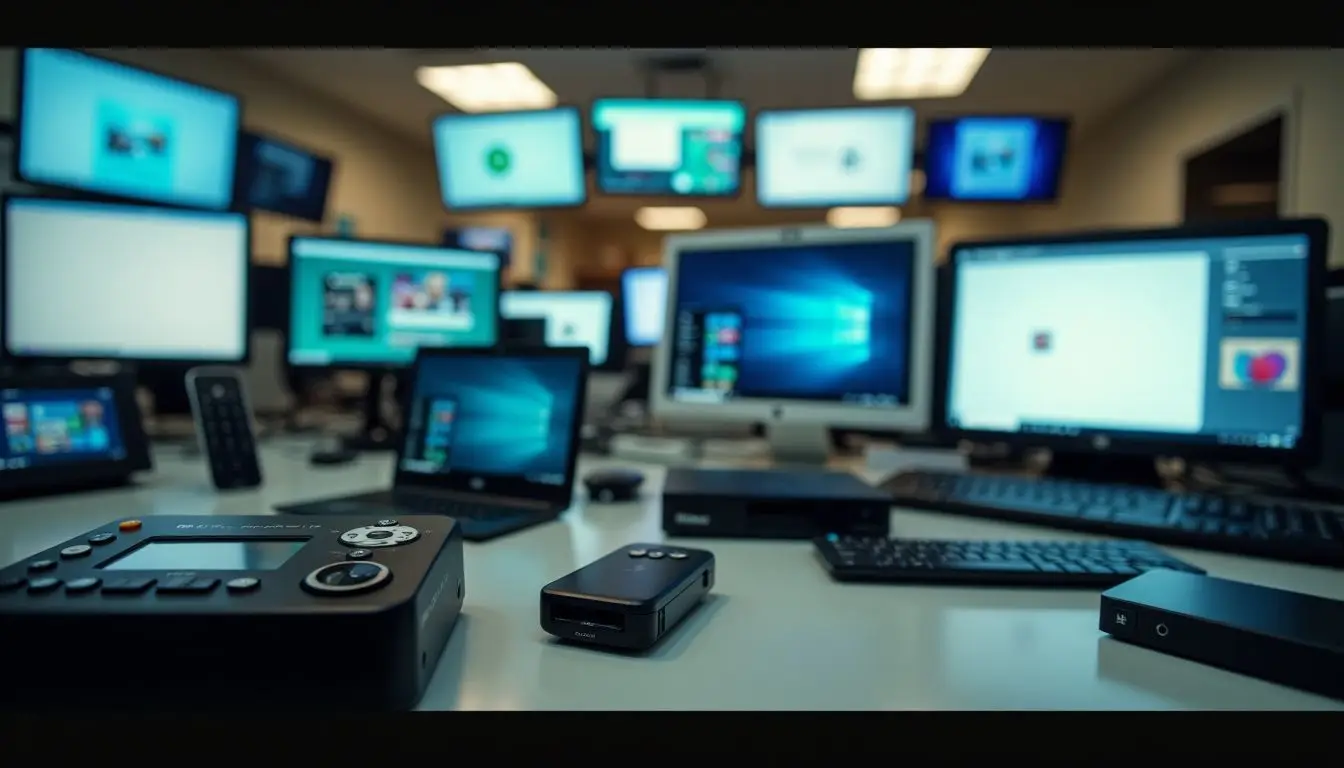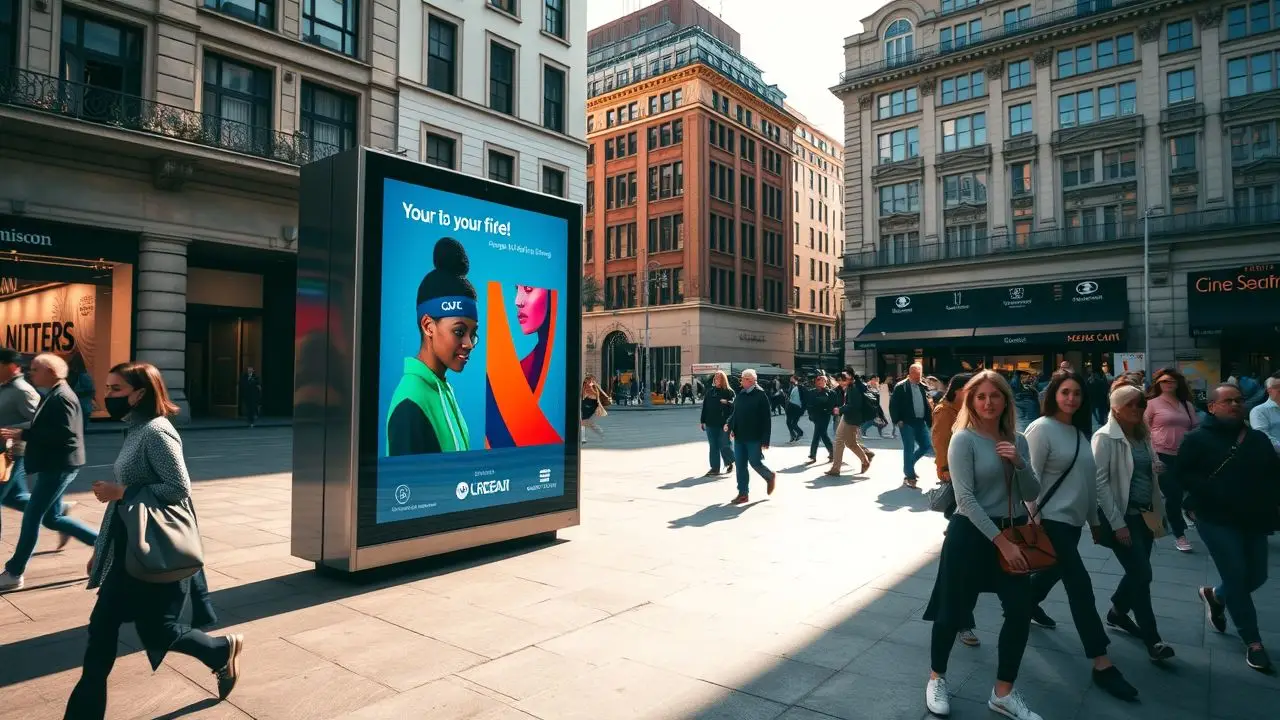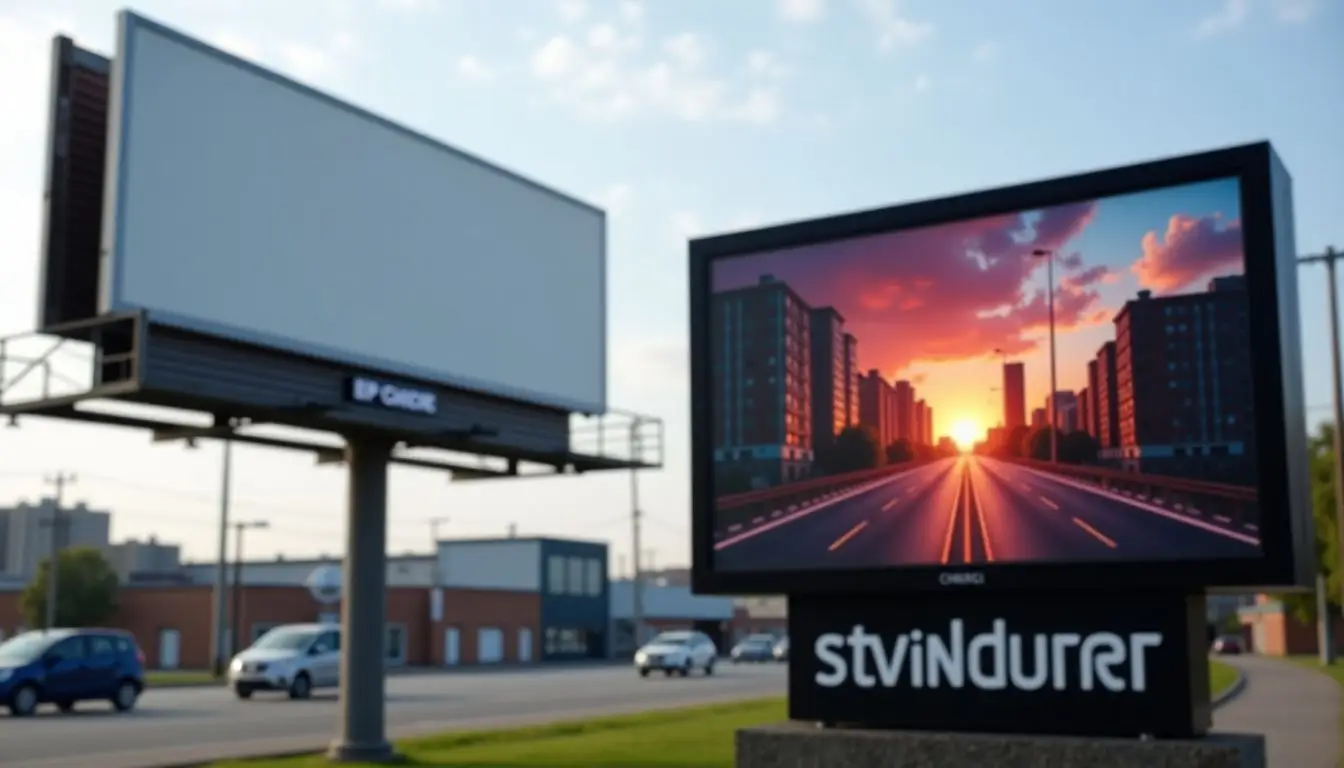Offices need good ways to share information. Digital signage is a popular and modern solution. This guide will show you how digital signs can change the way offices communicate. Keep reading to learn more!
Key Takeaways
- Digital signage uses screens to show information or ads. It combines hardware like displays and media players with software for easy content management.
- Different types of digital signs, such as LED, LCD, projection, OLED, e-paper displays, interactive touchscreens, and 3D displays cater to various office needs. These technologies enhance communication by making information more engaging.
- Setting up digital signage involves choosing the right hardware, pairing screens correctly, creating engaging content, scheduling it efficiently, and using tools like ScreenCloud for smooth management.
- Benefits of digital signage in office buildings include customizable and eye-catching displays that can show real-time updates. They are also energy efficient.
- Emerging technologies like AI and virtual reality add new possibilities for making office communications interesting and effective.
Table of Contents
ToggleWhat is Digital Signage and How Does it Work?

Digital signage uses electronic displays to show information, ads, or messages. It works with hardware and software that let you manage the content easily.
Hardware

Hardware for digital signage includes the screens and media players. Screens come in many types, like LCD and LED displays. These options offer clear images and vibrant colors. Media players are small devices that store and play your content.
They manage multimedia content easily.
When choosing hardware, consider the size of your office space. Large screens work well in big areas, while smaller ones suit tighter spots. First-hand experience shows that high-quality hardware can improve engagement with audiences.
Using reliable equipment increases ROI for businesses too.
Software

Software plays a vital role in digital signage. It controls what shows on the screens. Good software allows easy updates and changes to content. This helps with audience targeting and business communication.
Users can create visual balance and engage viewers effectively.
Popular systems include options for scheduling content and managing displays remotely. Some even offer interactive signage features, which boost engagement. First-hand experience shows that the right software makes managing digital displays smooth and efficient.
Quality software also supports energy-efficient operations in office technology solutions, saving money over time.
Support & Services

Support and services play a key role in digital signage. They help office buildings use electronic signage effectively. Technical support can fix problems quickly so screens stay on longer.
Services also include content programming and design. This ensures the right information reaches employees.
Many companies offer training for staff too. First-hand experience shows that well-trained teams manage digital messaging better. Regular updates keep displays fresh and engaging. Responsive service boosts workplace communication and makes marketing efforts more successful.
Types of Digital Signage

Digital signage comes in many forms. Some use screens for ads, while others display information or art.
Traditional billboards vs. digital signages

Comparing traditional billboards and digital signages reveals distinct differences in their features and how they are used in advertising and information sharing. Here’s a simplified breakdown:
| Feature | Traditional Billboards | Digital Signages |
|---|---|---|
| Update Method | Manual replacement needed | Updates over the network |
| Content Type | Static images or text | Dynamic content, including videos |
| Engagement Level | Lower impact due to static nature | Higher impact, can include interactive elements |
| Cost Over Time | Lower initial cost, higher maintenance and update costs | Higher initial cost, lower maintenance and update costs |
| Flexibility | Fixed message until manually changed | Messages can change throughout the day |
| Visibility | Depends on location and design | Bright and visible even in low light |
Traditional billboards have been a long-standing choice for outdoor advertising, offering wide visibility. Yet, they lack the flexibility and dynamic nature of digital signages. On the other hand, digital signages offer the advantage of easily changing content, which can be tailored to different times of the day or specific audiences. This makes digital signages a more versatile and engaging option for office buildings looking to display information or advertisements.
Different display technologies
Digital signage uses various display technologies. Each type has unique features that serve different needs.
- LED displays are bright and colorful. They work well both indoors and outdoors. These screens catch the eye and can show dynamic content.
- LCD screens provide clear images. They are often used in offices for digital advertising and marketing messages. Their sharp displays make them great for corporate signage.
- Projection systems can create large images on walls or screens. This type is useful for big presentations or events in office buildings. They can show videos or slideshows effectively.
- OLED screens offer deep blacks and vibrant colors. These displays are thinner than traditional screens, making them sleek options for modern spaces.
- E-paper displays use less energy than other types. They are perfect for showing static information like schedules or wayfinding signs.
- Interactive touchscreens allow users to engage with the content directly. This technology enhances office communication by giving people access to information easily.
- 3D displays create depth in visuals without glasses. They can make content more interesting and engaging, drawing viewers in better than flat displays.
These different display technologies help offices communicate efficiently using cutting-edge technology like digital signage.
Emerging technologies
Emerging technologies are changing digital signage for office buildings. These advancements include interactive displays and touch screens that engage viewers more effectively. 3D holograms also draw attention, creating a unique experience.
Smart AI software can analyze viewer behavior. It helps businesses present relevant marketing and information instantly. This technology makes content strategy easier and more efficient.
Other options like virtual reality add a fun twist to traditional office displays too. Companies enjoy the benefits of cutting-edge technology in their spaces while keeping them modern and inviting.
Benefits of Digital Signage for Office Buildings

Digital signage makes office buildings more engaging and informative. It allows for easy updates and eye-catching displays. This technology saves energy too. You can tailor content to fit any need.
Discover how it can transform your space!
Customization
Customization makes digital signage easy to use. Offices can change messages based on their needs. This adds a personal touch to the displays. Signs can show company news, events, or even break times.
Many businesses want content design that fits their brand. They choose colors and images that match their style.
First-hand experience shows that customized signs grab attention better than standard ones. People notice bright colors and unique designs more easily. Office buildings with commercial displays often see higher engagement from workers and visitors.
Customization helps communicate important information in a clear way.
Eye-catching
Digital signage grabs attention. Bright colors and moving images stand out in an office setting. These displays can show videos, graphics, or live updates. This makes them more interesting than traditional signs.
Office buildings get a modern look with digital screens. People notice these signs more easily. Engaging content keeps visitors informed and entertained. Digital signage is cutting-edge technology that adds flair to any space.
Diverse options
Digital signage offers many diverse options for office buildings. These options include different display types, sizes, and formats. You can choose from screens that fit your needs best, whether they are large wall displays or small kiosks.
Each type has its own purpose.
Office spaces can use digital signs in various ways. For instance, you might show important announcements on one screen while displaying fun graphics on another. This cutting-edge technology allows for creativity and flexibility in how information is shared with staff and visitors alike.
Real-time and reactive
Digital signage for office buildings can change instantly. This helps keep information up-to-date. For example, companies can show important news as it happens or update events quickly.
This feature keeps everyone in the loop.
Real-time content makes messages more engaging. Employees and visitors react to current updates right away. They see alerts, announcements, and promotions without waiting for printed signs to change.
The Ultimate Guide to Digital Signage for Office Buildings shows how this cutting-edge technology improves communication in workspaces daily.
Energy-efficient
Energy-efficient digital signage helps offices reduce power costs. These signs use LED technology, which consumes less energy than traditional lights. This means lower electricity bills and a smaller carbon footprint.
Many displays also have smart sensors. They can adjust brightness based on the amount of light in the room. This feature ensures they only use energy when needed. The Ultimate Guide to Digital Signage for Office Buildings shows how this cutting-edge technology benefits both businesses and the environment.
How to Set Up Digital Signage for Office Buildings

Setting up digital signage for office buildings starts with selecting the right hardware and pairing screens effectively. Create engaging content that fits your brand’s message. Schedule this content to keep it fresh and relevant.
Using tools like ScreenCloud helps manage everything smoothly. Learn more about each step!
Choosing the right hardware
Choosing the right hardware is key for digital signage. Start with displays that fit your office space. These can be LED or LCD screens. Ensure they have good brightness and resolution so everyone can see clearly.
Look for media players that sync well with your screens. They help show content smoothly. Some brands specialize in digital signage solutions, like ScreenCloud, which supports many types of hardware.
This makes setup easier and more effective for office buildings using cutting-edge technology. Testing the equipment before installation helps make sure it works as needed.
Pairing screens
Pairing screens is essential for effective digital signage in office buildings. Use multiple displays to create a larger image or video. This makes your content more engaging and visible from far away.
Screens should match in size and resolution for the best results.
Connect the screens using appropriate cables. Ensure all devices are compatible with your software. Good alignment helps avoid gaps between images on different screens. An organized setup enhances the overall look of your display, making it eye-catching and professional.
Creating content
Creating content for digital signage is key. Focus on clear messages and bright visuals. Use images, videos, and text that grab attention quickly. Keep the design simple and easy to read.
Aim for a professional look that fits your office’s style.
Plan what you want to show ahead of time. Update content regularly to keep it fresh. Include important information like events or announcements. Digital signage helps share this in real-time, making communication effective in office buildings using cutting-edge technology.
Scheduling content
Scheduling content is vital for effective digital signage in office buildings. It allows businesses to plan what they want to show at specific times. For instance, a company can display welcome messages in the morning and important updates in the afternoon.
This way, information reaches employees and visitors when it matters most.
Using software tools makes scheduling easy. These tools often have a simple interface that anyone can use. First-hand experience shows that using these programs boosts engagement with the displays.
They help keep content fresh and relevant throughout the week or month without much hassle. This organized approach supports clear communication within an office building while embracing cutting-edge technology.
Using ScreenCloud for management
ScreenCloud makes managing digital signage easy. This software allows you to control content on all your screens from one place. The user-friendly interface helps you schedule messages and update displays in real time.
Many offices use ScreenCloud for its flexibility. You can customize your screens to fit any need, from announcements to events. First-hand experience shows that it saves time and reduces stress for staff members handling updates.
With ScreenCloud, office buildings can stay current with cutting-edge technology while efficiently sharing information.
FAQs
1. What is the ultimate guide to digital signage for office buildings?
The ultimate guide to digital signage for office buildings provides comprehensive information on how to use cutting-edge technology in display screens, interactive kiosks, and other types of electronic signs in an office setting.
2. How can cutting-edge technology improve digital signage in my office building?
Cutting-edge technology can enhance your digital signage by providing high-quality images, real-time updates, and interactive features that engage employees and visitors alike.
3. Why should I consider using digital signage in my office building?
Digital signage offers a modern way to communicate important messages, share information about events or meetings, and improve overall engagement within your workspace.
4. Is it hard to implement digital signage into my existing infrastructure?
No! The ultimate guide will provide you with step-by-step instructions on how best to integrate this innovative tech into your current setup seamlessly.





